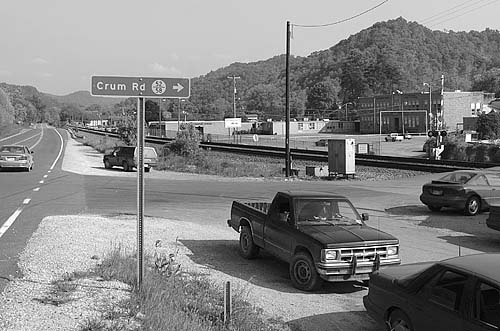Redeeming the Real Crum
Text and photographs by Carl E. Feather

The town of Crum, Wayne County. U.S. Highway 52 is visible at left. At the center is Crum Elementary School, and to the right is the two-story Crum Middle School, housed in what used to be the old high school building. Running the length of the photograph, and the length of the town, are the Norfolk & Southern railroad tracks. Photograph by Carl Feather.
The first thing I noticed about Crum, Unincorporated, was the traffic jam. A Norfolk & Southern train was stalled on the track that runs parallel to U.S. Route 52 and School Street, the main thoroughfare through this town in extreme southwestern Wayne County. The train blocked both Crum Road and Crum Hollow Road, the only two roads into downtown Crum. Lines of vehicles, four-to-six deep, spilled out of the short nub of road between Route 52 and the railroad crossing gates, slowing the otherwise swiftly moving traffic.
Such is the price of progress.
It was around 6:15 p.m. on a Wednesday evening, and like many of the other motorists stalled by this inconvenience, Margie Allen and her daughter were heading to midweek service at the Crum Church of Christ, a brick structure adjacent to the Crum Pizza Shop on School Street. Margie was standing outside her minivan, talking to a friend in the car in front of her, when I approached on foot.
She gave me a big smile, friendly “hello,” and asked if I knew why the train had stalled at the crossings. I didn’t have a clue, although the next day I learned that the culprit was Tunnel No. 4, a mile-long railroad tunnel just north of town. The rail line is reduced to one set of tracks at the tunnel, and low-priority rail traffic, like the train that blocked the crossings, must acquiesce to fast freight at the tunnel.
I learned this from Herb Dawson, a Crum native who holds bachelor’s and master’s degrees from Marshall University. He retired from teaching in 2000 to pursue his passion for local genealogy. He can tell you who married whom in Crum, where they are buried, and what they did between those events. Books containing his research fill shelf after shelf, bookcase after bookcase, of his Rear School Street home.
You can read the rest of this article in this issue of Goldenseal, available in bookstores, libraries or direct from Goldenseal.